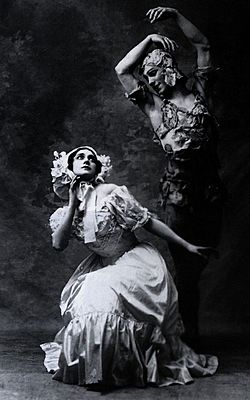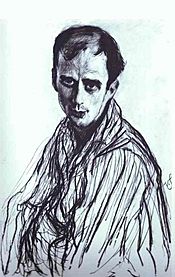Le Spectre de la rose facts for kids
Quick facts for kids Le Spectre de la rose |
|
|---|---|

Karsavina and Nijinsky, 1911
|
|
| Choreographed by | Michel Fokine |
| Composed by | Hector Berlioz's orchestration of Carl Maria von Weber's Aufforderung zum Tanz as L'Invitation à la Valse |
| Libretto by | Jean-Louis Vaudoyer |
| Based on | Théophile Gautier's poem "Le Spectre de la rose" |
| Date of premiere | 19 April 1911 |
| Place of premiere | Théâtre de Monte-Carlo |
| Original ballet company | Diaghilev's Ballets Russes |
| Characters | The Young Girl The Rose |
| Designs by | Léon Bakst |
| Setting | The Young Girl's Bedroom, about 1830 |
| Created for | Tamara Karsavina Vaslav Nijinsky |
| Genre | Fantasy |
| Type | Neo-Classical ballet |
Le Spectre de la rose (which means The Spirit of the Rose in English) is a short ballet. It tells the story of a young girl. She dreams of dancing with the spirit of a rose. This rose was a souvenir from her very first ball. Jean-Louis Vaudoyer wrote the story for the ballet. He based it on a poem by Théophile Gautier.
The dances were created by Michel Fokine. The music is by Hector Berlioz. He took Carl Maria von Weber's piano piece Aufforderung zum Tanz (Invitation to the Dance) and arranged it for an orchestra. Léon Bakst designed the original stage settings and costumes.
The ballet first opened in Monte Carlo on April 19, 1911. Nijinsky danced the part of The Rose. Tamara Karsavina played The Young Girl. It was a huge success. Spectre became famous around the world. This was mostly because of the amazing leap Nijinsky made through a window at the end of the ballet.
Contents
How the Ballet Started
In 1911, Sergei Diaghilev was producing ballets for his company, the Ballets Russes. He wanted to show Nijinsky's ballet L'Après-midi d'un faune. But it wasn't ready yet. So, Diaghilev needed another ballet to perform instead.
The idea for Le Spectre de la rose came from a writer named Jean-Louis Vaudoyer. In 1910, he sent his ballet idea to Léon Bakst. Bakst designed sets and costumes for the Ballets Russes. Vaudoyer's idea was based on a poem by Théophile Gautier. It also used Carl Maria von Weber's piano music. Diaghilev really liked Vaudoyer's idea. He thought it would be easy to get ready quickly. He started working on it right away. Diaghilev also liked that the ballet could celebrate 100 years since Gautier's birth.
The Music of the Rose
In 1819, Carl Maria von Weber wrote a piano piece. It was called Afforderung zum Tanz (Invitation to the Dance). He also wrote a little story for his music. It was about a young man and woman meeting, dancing, and then leaving a ball. The music starts quietly. Then it becomes a beautiful and lively waltz. It ends with the quiet music from the beginning.
In 1841, Hector Berlioz arranged Afforderung for an orchestra. This orchestral version was used for a short ballet. It was part of Weber's opera Der Freischütz at the Paris Opéra. This was the same Berlioz version that was used for the ballet Le Spectre de la rose.
The Dance Moves
Michel Fokine finished creating the dances very quickly. It took him only three or four rehearsals. He later said that the ballet was almost like an improvisation. Grace Robert wrote in her book The Borzoi Book of Ballets that Spectre is a pas de deux. A pas de deux means a dance for two people.
However, it wasn't a traditional pas de deux. It didn't focus on old, difficult 19th-century dance moves. Instead, it was a modern dance. It had continuous movement and lots of feeling. Fokine changed the usual arm positions of classical ballet for Nijinsky. He used soft, curving movements for the arms and fingers. Nijinsky's character became both strong and delicate. He showed masculine power in his legs. But he had a feminine softness in his arms. Some of his gestures, as Ostwalt wrote, gave a "feminine aura" to the character.
Nijinsky's Special Costume
Léon Bakst designed Nijinsky's costume. It was made of silk and stretched to fit him. The costume was covered with silk rose petals. For every show, Nijinsky was sewn into his costume. After each performance, the wardrobe mistress would fix the petals. She used a curling iron to make them look fresh.
Nijinsky's make-up was also a very important part of his look. Romula de Pulszky, who later became his wife, said he looked like "a heavenly insect." She thought his eyebrows looked like a beautiful beetle. Ostwald wrote that Nijinsky's costume was like a ballerina's. Sometimes, petals would fall off during the show. Nijinsky's servant, Vasili, would collect them. He would then sell them as souvenirs. People even said he built a large house with the money he made from selling the petals!
Nijinsky's Amazing Leap
The ballet became very famous because of Nijinsky's incredible leap. He jumped through one of the two large windows on the stage. But the height of the leap was actually an illusion. Nijinsky would take five running steps from the middle of the stage. On the sixth step, he would leap through the window.
The wooden board under the window was very low. This made it look like his leap was much higher than it was. Behind the stage, four men would catch Nijinsky in the air. They would then put warm towels on him. No one in the audience ever saw Nijinsky land. It looked like he would just keep flying forever. The conductor in the orchestra pit also helped the illusion. He held the second-to-last chord for a long time. This made the leap feel even longer and higher.
The Story of the Ballet
The curtain opens on a girl's bedroom. The Young Girl enters the room. She is wearing a white bonnet and a ball gown. She has just come home from her first ball. She holds a rose as a souvenir of the evening. She sits in a chair and falls asleep. The rose slips from her fingers and falls to the floor.
Suddenly, the Spirit of the Rose appears at the window. He steps into the room and moves closer to The Young Girl. She is still asleep, but she rises and dances with him. He gently leads her back to the chair. He kisses her, then leaps through the window and disappears into the night. The Young Girl wakes up and rises. She picks up the rose she dropped and kisses it. The curtain then falls.
First Performance and Audience Reaction
| Fokine's Ballets |
|---|

Les Sylphides (1909) |
Spectre was first performed on April 19, 1911. It was presented by Diaghilev's Ballets Russes. The show took place at the Théâtre de Monte Carlo in Monte Carlo. Tamara Karsavina danced as The Young Girl. Nijinsky played The Rose.
Grace Robert wrote that Spectre was an "immediate success." Diaghilev was surprised by this. He thought Spectre was just a small, unimportant ballet. But this little ballet became one of the most loved shows of the Ballets Russes.
After Nijinsky's Time
Many dancers tried to perform as The Rose after Nijinsky. But they often found it very difficult. This was because the ballet was created especially for Nijinsky's unique talents. The Young Girl's role has sometimes been called "the forgotten woman of ballet." Over time, her part became more ordinary. By the mid-20th century, Spectre was mostly known for one thing: people paid just to see the famous leap through the window.
Spectre was one of the first ballets Rudolph Nureyev danced in the West. This was after he left Russia. He performed it for German television in 1961. He first danced The Rose on stage in New York City in 1979. He performed it 24 times for the Joffrey Ballet's Diaghilev program. Spectre was also the last ballet Nureyev and Margot Fonteyn danced together. This was in June 1979, when Fonteyn was 60 years old. Nureyev danced The Rose in Paris in 1981 and 1982. He last performed the role in August 1987 in London.
The ballet was first seen in Australia in 1936. It was part of the Monte Carlo Russian Ballet program. In 1962, Margot Fonteyn danced The Young Girl. This was during her tour of Australia. In 2006, The Australian Ballet performed the ballet. It was one of three ballets they showed that highlighted Fokine's work.
See also
 In Spanish: El Espectro de la rosa para niños
In Spanish: El Espectro de la rosa para niños


